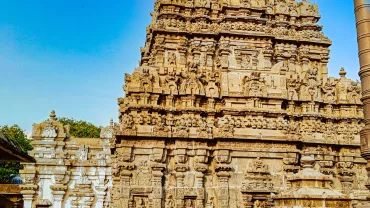About Sri Kurmanadha Swamy Temple
This temple is dedicated to the Kurma avatar of the Hindu god Vishnu, who is worshipped as Kurmanatha Swamy, and his consort Lakshmi worshipped as Kurmanayaki. According to Hindu legend, the presiding deity is believed to have manifested here in the form of a tortoise-shaped deity. Brahma then consecrated the deity with Gopala Yantra. The temple is famous for ancestor worship.
Sri Kurma is the only Indian temple in the world where Vishnu is worshiped in his Kurma avatar. Initially dedicated to Shiva and referred to as Kurmeswara temple, Ramanuja is said to have converted Srikurmam into a Vaishnavite temple in the 11th century CE. Since then, the temple was regarded as an important center of Vaishnavism in the medieval period along with Simhachalam. Later Naraharitirtha, a disciple of Madhvacharya, was instrumental in making Srikurmam the seat of Vishnavite religious activities. The temple has two dhvajasthambas, a rarity for a Vaishnavite temple.
108 Ekasila pillars, with none resembling each other, history of the temple begins in the 11th-12th centuries and is popular among the Tamil diaspora as well because it is a Vaishnavite temple. Initially dedicated to Shiva and referred to as Kurmeswara temple, Ramanuja is said to have converted Srikurmam into a Vaishnavite temple in the 11th century CE. His disciples established Vaishnavism in the temple with the support of Kalinga king Anantavarman Chodaganga, the eastern Ganga king. After this incident, a group of devadasis was employed to sing and dance daily before the deity in the morning and evening.
Sri Kurma was regarded as an important center of Vaishnavism in the medieval period along with Simhachalam and others. It was also regarded as the Gurupitha of the Ganga kings of Utkala. Naraharitirtha, the disciple of Madhvacharya, was instrumental in making Srikurmam the seat of Vishnavite religious activities. He also defended the place from an attack of the Sabaras, a group of savage inhabitants of the Ganjam forests. Srikurmam influenced the kings, officials, and Vaishnavite devotees to change their names per the religious faith they followed.
Due to his close association with the eastern Ganga kings, Naraharitirtha created the office of Bhoga Pariksha to have the successive Madhwa saints supervise religious matters and pray for the welfare of the royal family and kingdom. Naraharitirtha later built a temple dedicated to Yogananda Narasimha in front of Srikurmam. The temple inscriptions mention Narasimha Dasa Pandita and Purushottama Deva as the Bhoga Parikshas. Currently, Srikurmam is under the trusteeship of the Gajapathi Rajus of Vizianagaram.
During the reign of king Swetha Chakravarthi, this area was referred to as Swetha Giri. Swetha Chakravarthi’s wife Vishnu Priya was a devotee of Vishnu. When she was observing a fast on an Ekadasi day, Swetha Chakravarthi approached her intending to make love. When she refused, saying the time was not ideal, the king became adamant. She prayed to Vishnu, who created a stream of water, separating the couple. Swetha Chakravarthi was carried away in the ensuing flood and Vishnu Priya followed him to the hilly terrains of Swetha Giri.
The sage Narada initiated a Upadesam of the Kurma Narayana mantra and asked the king to pray to Vishnu using it. By the time Vishnu appeared in the form of the Kurma avatar, the king’s health had deteriorated. Vishnu then made his Sudarshana Chakra make an impression in the nearby land, forming a lake. Swetha Chakravarthi bathed in the lake and regained his health, after which it was referred to as Swetha Pushkarani.
Upon the king’s request, Vishnu manifested as the deity of Kurmanatha. According to the Padma Purana, Brahma officiated the celestial rituals and consecrated the deity with Gopala Yantra. Vishnu is worshipped as Kurmanatha Swamy or Kurma Narayana, along with his consort Lakshmi, who is referred to as Kurmanayaki.
Later, a tribal king visited the Swetha Pushkarani and was impressed with it. After learning about the story of its origin from Swetha Chakravarthi, the tribal king constructed a tank around the lake and began worshipping the deity regularly. The tribal king used to stay in Sage Sampangi’s monastery, which was situated on the Western side of the temple. Upon the king’s request, the deity started facing west. The sage Durvasa visited the Sri Kurmanadha Swamy Temple later with his disciples; the event of his arrival was considered significant.
Rama’s sons Lava and Kusha were said to have worshipped Vishnu as Kurmanatha in Srikurmam. In Dvapara Yuga, Balarama visited the Sri Kurmanadha Swamy Temple and was denied entry by Bhairava, who was serving as the temple’s Kshetrapala. Infuriated, Balarama threw Bhairava away from the Sri Kurmanadha Swamy Temple premises. Kurmanatha came to know this and gave Balarama permission to enter the Sri Kurmanadha Swamy Temple. Balarama, in resentment, cursed that Srikurmam would be the only temple where Vishnu would be worshipped in the form of Kurma Narayana. Legends also say that upon Vishnu’s request, Anjaneya agreed to guard the Sri Kurmanadha Swamy Temple.
Timings to Visit
06:00 AM – 07:45 PM.
Sevas perform at Sri Kurmanadha Swamy Temple
Abhishekam:
Cost: Rs.200/- per couple
Timings: 4:30 AM to 6 AM
Kalyanotsavam:
Cost: Rs.516/- per couple
Timings: 9 AM
Suprabhata Seva, Nityabhishekam, Prabhodika, Mangala Snanam, Thiruvaradana, Sarva darshan, Balabhogam:
Timings: 06:00 AM to 12:00 PM
Rajabhogam:
Timings: 12 PM
Nitya Thiruvaradana, Amngalasnanam:
Timings: 7 PM
Pavalimpu Seva:
Timings: 8 PM
How To Reach Sri Kurmanadha Swamy Temple
By Air: Visakhapatnam Airport – 110 km
By Rail: Srikakulam railway station – 25 km,
By Road: Srikakulam old bus station – 15 km.
Address
Sri Kurmanadha Swamy Temple, Srikakulam District, Andhra Pradesh 532404, India
Also Read Place To Visit In And Around Srikakulam District
Srikakulam Hotels Booking
Booking.com
Sri Kurmanadha Swamy Temple Map
